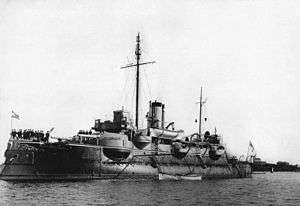SMS Hildebrand
 SMS Hildebrand' sister ship SMS Beowulf | |
| History | |
|---|---|
| Name: | Hildebrand |
| Namesake: | Hildebrand |
| Builder: | Kaiserliche Werft in Kiel |
| Laid down: | 9 December 1890 |
| Launched: | 6 August 1892 |
| Commissioned: | 28 October 1893 |
| Fate: | Sunk off Dutch coast, 1919, scrapped 1933 |
| General characteristics as built | |
| Class and type: | Siegfried-class coast defense ship |
| Displacement: | 3,500 metric tons (3,400 long tons) |
| Length: | 79 m (259.2 ft) |
| Beam: | 14.8 m (48.6 ft) |
| Draft: | 5.74 m (18.8 ft) |
| Installed power: | 4,800 ihp (3,600 kW) |
| Propulsion: |
|
| Speed: | 14.8 knots (27.4 km/h; 17.0 mph) |
| Range: | 4,800 nmi (8,900 km; 5,500 mi) at 10 knots (19 km/h; 12 mph) |
| Complement: |
|
| Armament: |
|
| Armor: |
|
SMS Hildebrand was the fifth vessel of the six-member Siegfried class of coastal defense ships (Küstenpanzerschiffe) built for the German Imperial Navy. Her sister ships were Siegfried, Beowulf, Frithjof, Heimdall, and Hagen. Hildebrand was built by the Kaiserliche Werft Kiel shipyard between 1890 and 1893, and was armed with a main battery of three 24-centimeter (9.4 in) guns. She served in the German fleet throughout the 1890s and was rebuilt in 1900–1902. She served in the VI Battle Squadron after the outbreak of World War I in August 1914, but saw no action. Hildebrand was demobilized in 1915 and used as a barracks ship thereafter. She ran aground while en route to the Netherlands for scrapping in 1919, and was eventually broken up in situ in 1933.
Design

Hildebrand was 79 meters (259 ft) long overall and had a beam of 14.9 m (49 ft) and a maximum draft of 5.74 m (18.8 ft). She displaced 3,741 long tons (3,801 t) at full combat load. Her propulsion system consisted of two vertical 3-cylinder triple expansion engines. Steam for the engines was provided by four coal-fired boilers. The ship's propulsion system provided a top speed of 14.8 kn (27.4 km/h; 17.0 mph) and a range of approximately 1,490 nautical miles (2,760 km; 1,710 mi) at 10 kn (19 km/h; 12 mph). Hildebrand had a crew of 20 officers and 256 enlisted men.[1]
The ship was armed with three 24 cm K L/35 guns mounted in three single gun turrets. Two were placed side by side forward, and the third was located aft of the main superstructure. They were supplied with a total of 204 rounds of ammunition. The ship was also equipped with eight 8.8 cm SK L/30 guns in single mounts. Hildebrand also carried four 35 cm (14 in) torpedo tubes, all in swivel mounts on the deck. One was at the bow, another at the stern, and two amidships. The ship was protected by an armored belt that was 240 mm (9.4 in) amidships, and an armored deck that was 30 mm (1.2 in) thick. The conning tower had 80 mm (3.1 in) thick sides.[2]
Service history
Hildebrand was laid down in 1890 at the Kaiserliche Werft shipyard in Kiel. She was launched on 6 August 1892, and completed on 28 October 1893.[3] Hildebrand participated in the fleet maneuvers in 1894, alongside two of her sister ships in the IV Division of the fleet. The Division was based in Danzig with some torpedo boats and operated as the German fleet in mock engagements with the I Division, which simulated the Russian Baltic Fleet.[4] In 1897, Hildebrand again participated in the annual summer maneuvers in the III Division, along with Siegfried and Beowulf. Her other three sisters were assigned to the IV Division.[5] Hildebrand, Siegfried, Heimdall, and Ägir simulated the hostile fleet during the 1900 summer exercises.[6]
Hildebrand served on active duty with the fleet until 1901, when she was taken into drydock at the Kaiserliche Werft shipyard in Danzig for an extensive reconstruction. The ship was lengthened to 86.13 m (282.6 ft), which increased displacement to 4,236 t (4,169 long tons; 4,669 short tons).[7] Her old boilers were replaced with eight new Marine type boilers, and a second funnel was added. Her secondary battery was increased to ten 8.8 cm guns, and the 35 cm torpedo tubes were replaced with three 45 cm (18 in) tubes. Work was completed by 1902.[1]
Hildebrand returned to the fleet after her modernization was completed, assigned to the II Squadron, alongside Heimdall, Hagen, and Beowulf.[8] She remained in the fleet where she remained until the outbreak of World War I in August 1914, when she was mobilized into the VI Battle Squadron for coastal defense, along with her sister ships. On 31 August 1915, the VI Battle Squadron was demobilized, and Hildebrand's crew was transferred to other warships.[9] She was then used as a barracks ship in Windau. On 17 June 1919, she was stricken from the naval register. She was sold to the Netherlands for scrapping, but ran aground while en route to the breakers. In 1933, her wreck was blown up and subsequently broken up in situ.[2]
Notes
References
- Gardiner, Robert, ed. (1979). Conway's All the World's Fighting Ships 1860–1905. Greenwich: Conway Maritime Press. ISBN 0-8317-0302-4.
- Gardiner, Robert; Gray, Randal, eds. (1984). Conway's All the World's Fighting Ships: 1906–1922. Annapolis, MD: Naval Institute Press. ISBN 0-87021-907-3.
- Gröner, Erich (1990). German Warships: 1815–1945. Annapolis, MD: Naval Institute Press. ISBN 0-87021-790-9.
- "Notes on Naval Progress". General Information Series. Government Printing Office. XVII. 1898.
- "Notes on Naval Progress". General Information Series. Government Printing Office. XX. 1900.
- Sondhaus, Lawrence (1997). Preparing for Weltpolitik: German Sea Power Before the Tirpitz Era. Naval Institute Press: Annapolis. ISBN 1-55750-745-7.
- The United Service. New York: L. R. Hamersly, Jr. V. 1904. Missing or empty
|title=(help)